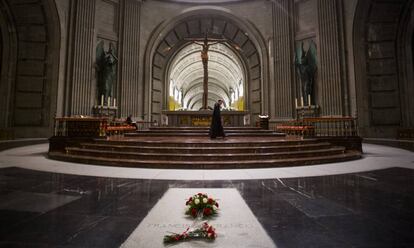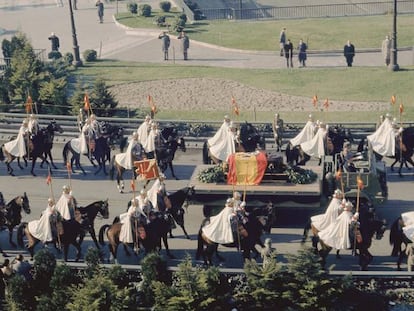Spanish government set to approve exhumation of Francisco Franco
The dictator’s family, who will be given 15 days to choose an alternative resting place, have promised to fight the decision at the Supreme Court


The Spanish government is planning on approving an agreement at a Cabinet meeting on Friday that would give the final green light for the exhumation of the body of dictator Francisco Franco from the controversial Valley of the Fallen monument, located northwest of Madrid. The agreement outlines that the government has the “legal mandate” to remove the dictator’s tomb from a place of worship. Once approved, the Franco family will have 15 days to choose an alternative resting place for the dictator.
Spain’s National Heritage Trust, the state agency that administers properties belonging to Spain and the Spanish royal family, has a plan to complete the exhumation in a few hours, with “minor” work costing less than €3,800.
The Cabinet’s decision will bring to a head a lengthy process that has caused a number of headaches for the Socialist Party (PSOE) government of Prime Minister Pedro Sánchez. Although Spain’s Congress approved a decree to allow the exhumation on August 24, the process has been delayed by several months due to opposition by Franco’s family, foundations associated with the dictator and the Valley of the Fallen, which filed multiple complaints and appeals against the decree, members and officials of the ministries involved, as well as the National Heritage Trust, which administers the monument.
The exhumation has been delayed by several months due to opposition from Franco’s family
According to the agreement, if the Franco family – which is fiercely opposed to their grandfather being removed from the Valley of the Fallen – does not specify a new resting place, the government will decide on the site. The most probable option is the Mingorrubio cemetery, near El Pardo on the northern outskirts of Madrid, where the dictator’s wife is buried.
The agreement states that “the decision [on the new burial site] will fall to the government, which will do it with the highest respect for the dignity of the family and the appropriate decorum.” It adds that the government’s decision has “all the necessary legal guarantees to ensure its legality.”

Exhumation
The Justice Ministry has a report from the National Heritage Trust on what structural work needs to be done to the Santa Cruz Basilica – which houses Franco’s tomb – for the dictator’s body to be removed. This document was sent to San Lorenzo de El Escorial City Hall, where the basilica is located, in order to obtain the necessary permissions to remove the thick granite tombstone.
According to the plan from the National Heritage Trust, once Franco’s body is exhumed, workers will have to move his tomb and cover the space with six black marble tiles identical to the existing ones. The state agency assures this is a simple, “minor” job that could be done by any funeral home in a matter of hours, but has not indicated which company will be responsible for the task. It adds that the work “should not affect the architectural considerations of the property.” The budget for the exhumation is just €3,738.
Opposition
The move to remove Franco’s remains from the Valley of the Fallen was one of Sánchez’s star policies when he came to power in June through a no-confidence motion against Mariano Rajoy of the Popular Party (PP), but he had been unprepared by the backlash from the Franco family.
The plan to complete the exhumation will take just a few hours, with the “minor” work costing less than €3,800
When the Franco family realized that they could not avoid the exhumation, they instead demanded the body be reburied next to the grave of his daughter, Carmen Polo, in La Almudena cathedral, a landmark building in central Madrid that attracts thousands of visitors. The government decided that it could not let this happen under any circumstances – no European dictator currently rests in a cathedral.
To stop the Franco family from reburying the dictator’s remain in La Almudena, the central government’s delegate in Madrid published a report at the end of December concluding that the body must not be interred in the cathedral on reasons of public order, the risk of terrorist threats, and the possibility of confrontations between supporters and detractors in the crypt itself, a holy site where the police would not be able to enter.
Valley of the Fallen
The 13.6-square kilometer Valley of the Fallen site remains hotly contested in a country still struggling to come to terms with the legacy of the dictatorship of Franco, who was the Spanish head of state from the end of the Civil War in 1939 to his death in 1975.
The site was ostensibly built to commemorate all of the victims on both sides of Spain’s bitter and bloody Civil War, and the remains of more than 33,000 victims of the conflict lie there. But critics point out that the Valley of the Fallen, which features a basilica and a 150-meter-high cross that dominates the surrounding countryside, contains just two marked graves: those of Franco himself and José Antonio Primo de Rivera, the founder of the Falange, Spain’s fascist-inspired political party. At the same time, thousands of prisoners of war who fought against Franco in the civil conflict were among the workforce used in its construction.
More delays?
The lawyer for the Franco family, Luis Felipe Utrera-Molina, says he will review the agreement on Friday and immediately contact the Spanish government "in writing" to communicate the family's intention to appeal the decision at the Supreme Court and file measures to stop the exhumation. The family has up to two months to take action and is likely to wait to see how the political situation in Spain plays out, given general elections have been called for April 28.
Spain's National Heritage Trust has delivered a report on the work required for the exhumation to San Lorenzo de El Escorial City Hall in order to obtain the necessary permits. But the local authorities have been swamped with 13 legal appeals and another three against the City Hall itself. Most of the complaints target the competency of the local authorities and argue that the exhumation does not fall under a license for minor work.
English version by Melissa Kitson.
Tu suscripción se está usando en otro dispositivo
¿Quieres añadir otro usuario a tu suscripción?
Si continúas leyendo en este dispositivo, no se podrá leer en el otro.
FlechaTu suscripción se está usando en otro dispositivo y solo puedes acceder a EL PAÍS desde un dispositivo a la vez.
Si quieres compartir tu cuenta, cambia tu suscripción a la modalidad Premium, así podrás añadir otro usuario. Cada uno accederá con su propia cuenta de email, lo que os permitirá personalizar vuestra experiencia en EL PAÍS.
¿Tienes una suscripción de empresa? Accede aquí para contratar más cuentas.
En el caso de no saber quién está usando tu cuenta, te recomendamos cambiar tu contraseña aquí.
Si decides continuar compartiendo tu cuenta, este mensaje se mostrará en tu dispositivo y en el de la otra persona que está usando tu cuenta de forma indefinida, afectando a tu experiencia de lectura. Puedes consultar aquí los términos y condiciones de la suscripción digital.
More information
Archived In
Últimas noticias
From digital curfews to blocking apps: How technology experts protect their children online
Why the price of coffee has skyrocketed: from Brazilian plantations to specialty coffee houses
Confined to a Cuban hospital: When electricity is a matter of life or death
How Japan is trying to avert ‘digital defeat’
Most viewed
- Pablo Escobar’s hippos: A serious environmental problem, 40 years on
- Reinhard Genzel, Nobel laureate in physics: ‘One-minute videos will never give you the truth’
- Why we lost the habit of sleeping in two segments and how that changed our sense of time
- Charles Dubouloz, mountaineering star, retires at 36 with a farewell tour inspired by Walter Bonatti
- The Florida Keys tourist paradise is besieged by immigration agents: ‘We’ve never seen anything like this’










































